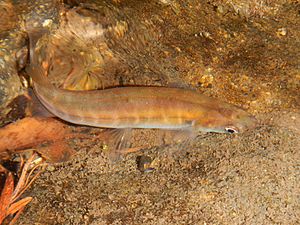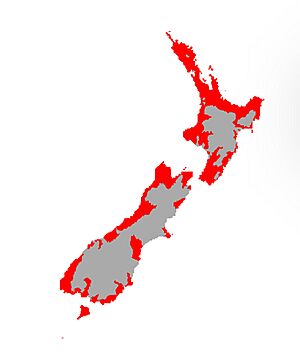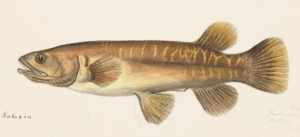Banded kōkopu facts for kids
Quick facts for kids Banded kōkopu |
|
|---|---|
 |
|
| Banded kōkopu | |
| Conservation status | |
| Scientific classification | |
 |
The banded kōkopu (Galaxias fasciatus) is a special type of fish. It belongs to a group called galaxiids. You can only find this fish in New Zealand, including the Chatham and Stewart/Rakiura islands.
This fish usually grows to be about 20–25 cm long. That's about the length of a ruler! Some have even been seen growing to around 30 cm. Young banded kōkopu are amazing climbers. They can climb up waterfalls and other steep, wet places. They do this by wiggling up the wet surface, using the water's stickiness and their big fins to grip.
Contents
What Does the Banded Kōkopu Look Like?
Banded kōkopu are strong, rounded fish. They have a large head and a big mouth. Like other fish in the galaxiid family, their back fin (dorsal fin) and bottom fin (anal fin) are close to their tail fin. Their tail fin is short and square-shaped.
Adult fish are usually a dark brown or olive green color. They have light yellow stripes or "bands" going up and down their body. Their belly is light-colored and plain. Right behind their gill cover, above their front fin, they have a silver or white mark. This mark helps tell them apart from other fish.
The bands on the fish can look different. They might fade out at the top and bottom. Or they might split and crisscross over the fish's back. When the fish are young, they have many bands all over their body. As they get older, the bands become thinner. They are often only found on the back part of the body. Even though the bands change with age, their shape and placement are unique. This means scientists can use them to identify individual fish for many years!
How to Tell Banded Kōkopu Apart from Other Fish
Sometimes, medium-sized or young giant kōkopu might look like banded kōkopu. This is because they can also have vertical stripes. But there's an easy way to tell them apart. Banded kōkopu have that special white or silver mark right behind their gill cover. Giant kōkopu do not have this mark.
Also, the stripes on banded kōkopu either split and spread across their back, or they fade out. The stripes on giant kōkopu never split. They always have a clear, sharp edge. Young shortjaw kōkopu might also be mistaken for very pale banded kōkopu. But shortjaw kōkopu have a much smaller mouth, which is a clear sign.
Where Do Banded Kōkopu Live?
Banded kōkopu are only found in New Zealand. Scientists know of only a few places where they lay their eggs. In 2018, a new egg-laying site was found near Nelson. This was in a small stream that flows into York Stream. This area had been improved to help fish live there.
In the Nelson area, banded kōkopu live in small creeks and streams. These are often found in low-lying coastal areas. They can also go further inland. They like to hide in pools or under banks with plants hanging over the water.
The Life Cycle of the Banded Kōkopu
Banded kōkopu are what we call "diadromous" fish. This means they spend part of their life in the sea and part in freshwater. They spend their first 3–4 months in the ocean. Then, they swim back to freshwater as young fish called whitebait. At this point, they are about 40–45 mm (1.6–1.8 in) long.
Banded kōkopu become old enough to have babies when they are two or three years old. They lay their eggs in autumn and early winter. This happens during floods. They lay their eggs, which are about 2 mm (0.079 in) wide, among flooded plants and leaves at the edge of the stream.
As the floodwaters go down, the eggs are left out of the water. But the plants keep them moist. After about three to four weeks, the baby fish inside the eggs are fully grown. They need another flood to make them hatch. The tiny baby fish are then carried out to sea by the floodwaters. They live among tiny ocean creatures for 3–4 months before returning to freshwater.
Young banded kōkopu can smell and are attracted to scents made by adult fish. This suggests they can recognize special smells from their own species. These smells might tell the young fish that an area is a good place to live because other adults are there.
Banded kōkopu can live for at least nine years, and maybe even longer! They can also lay eggs many times during their life.
How Banded Kōkopu Behave
Banded kōkopu are mostly active at night. You can watch them easily and quietly in the dark, especially using a red light. If they are not disturbed, you might also see them during the day.
Young banded kōkopu are one of the five types of galaxiid fish that are caught and eaten as whitebait.



